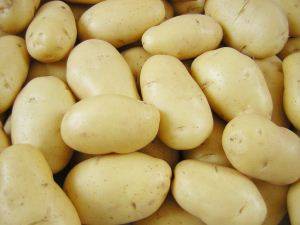The ancient Incas were cultivating this humble tuber thousands of years ago. The potato was not readily accepted in Europe, however, because it was known to be a member of the nightshade family (as are the tomato and eggplant) and therefore thought to be poisonous. In the 16th century, Sir Walter Raleigh was instrumental in debunking the poisonous potato superstition when he planted them on property he owned in Ireland. The Irish knew a good thing when they saw it and a hundred years later were growing and consuming the potato in great quantities. Today, hundreds of varieties of this popular vegetable are grown around the world. In America, the potato can be divided into four basic categories: russet, long white, round white and round red. Russet potatoes (also called old potatoes, baking potatoes and, sometimes, Idaho potatoes — after the state leading in production) have an elliptical shape with a rough, brown skin and numerous eyes. The russet's white flesh is somewhat dry and mealy after cooking. This potato's low moisture and high starch content make it excellent for baking, mashing and frying. Varieties include Russet Burbank, Russet Arcadia, Russet Norkotah and Butte. Long white potatoes have a similar shape as the russet but they have thin, pale gray-brown skins with almost imperceptible eyes. They're sometimes called white rose or California long whites, after the state in which they were developed. Long whites can be baked, boiled or fried. The thumb-size baby long whites are called fingerling potatoes. The medium-size round white and round red potatoes are also commonly referred to as boiling potatoes. They're almost identical except that the round white has a freckled brown skin and the round red a reddish-brown coat. They both have a waxy flesh that contains less starch and more moisture than the russet and long white. This makes them better suited for boiling (they're both commonly used to make mashed potatoes) than for baking. They're also good for roasting and frying. The round white is grown mainly in the Northeast where it's sometimes referred to by one of its variety names, Katahdin. The round red is cultivated mainly in the Northwest. Yukon gold potatoes have a skin and flesh that ranges from buttery yellow to golden. These boiling potatoes have a moist, almost succulent texture and make excellent mashed potatoes. There are a variety of relatively new potatoes in the marketplace, most of which aren't new at all but rather heritage vegetables that date back centuries. Among the more distinctive examples are the All Blue potatoes, which range in color from bluish purple to purple-black. These small potatoes have a dense texture and are good for boiling. Other purple potatoes have skin colors that range from lavender to dark blue and flesh that can be from white to beige with purple streaking. Among the red-fleshed potatoes are the huckleberry (red skin and flesh) and the blossom (pinkish-red skin and flesh). New potatoes are simply young potatoes (any variety). They haven't had time to convert their sugar fully into starch and consequently have a crisp, waxy texture and thin, undeveloped wispy skins. New potatoes are small enough to cook whole and are excellent boiled or pan-roasted. Because they retain their shape after being cooked and cut, new potatoes are particularly suited for use in potato salad. The season for new potatoes is spring to early summer. Potatoes of one variety or another are available year-round. Choose potatoes that are suitable for the desired method of cooking. All potatoes should be firm, well-shaped (for their type) and blemish-free. New potatoes may be missing some of their feathery skin but other types should not have any bald spots. Avoid potatoes that are wrinkled, sprouted or cracked. A green tinge — indicative of prolonged light exposure — is caused by the alkaloid solanine, which can be toxic if eaten in quantity. This bitter green portion can be cut or scraped off and the potato used in the normal fashion. Store potatoes in a cool, dark, well-ventilated place for up to two weeks. New potatoes should be used within three days of purchase. Refrigerating potatoes causes them to become quite sweet and to turn dark when cooked. Warm temperatures encourage sprouting and shriveling. Potatoes are probably the most versatile vegetable in the world and can be cooked in any way imaginable. They're available in a wide selection of commercial products including potato chips, instant mashed potatoes (dehydrated cooked potatoes), canned new potatoes and a plethora of frozen products including hash browns, french fries and stuffed baked potatoes. Potatoes are not at all hard on the waistline (a 6-ounce potato contains only about 120 calories) and pack a nutritional punch. They're low in sodium, high in potassium and an important source of complex carbohydrates and vitamins C and B-6, as well as a storehouse of minerals. Neither sweet potatoes nor yams are botanically related to the potato.
From The Food Lover's Companion, Fourth edition by Sharon Tyler Herbst and Ron Herbst. Copyright © 2007, 2001, 1995, 1990 by Barron's Educational Series, Inc.
Potatoes
Posted In: Food Ingredients
| Author:
Savita
Photo Credit: http://www.worldbulletin.net




